2022届高考英语二轮复习:句子成分及长难句分析课件(30张)
文档属性
| 名称 | 2022届高考英语二轮复习:句子成分及长难句分析课件(30张) |  | |
| 格式 | pptx | ||
| 文件大小 | 1.4MB | ||
| 资源类型 | 教案 | ||
| 版本资源 | 通用版 | ||
| 科目 | 英语 | ||
| 更新时间 | 2022-05-04 10:24:02 | ||
图片预览

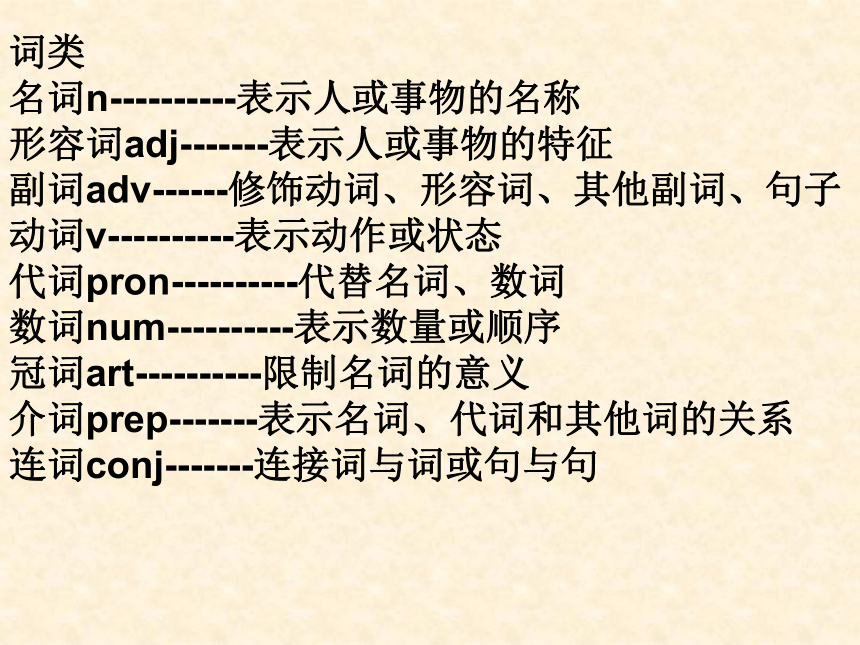
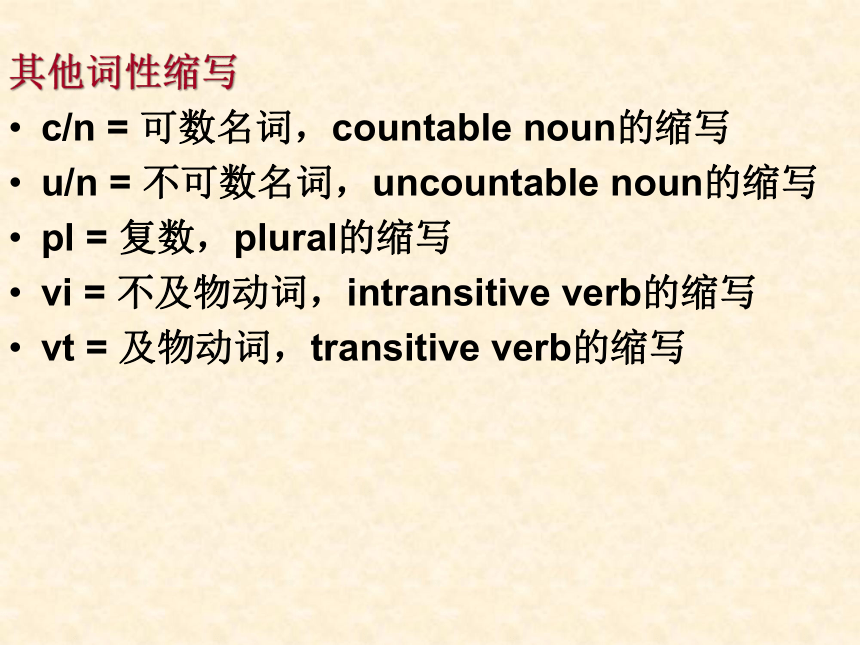

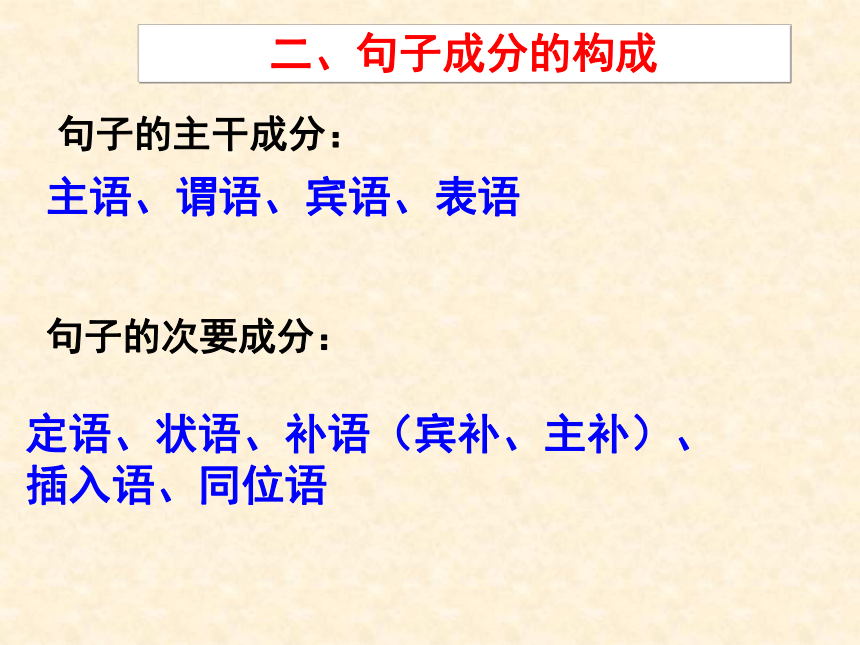
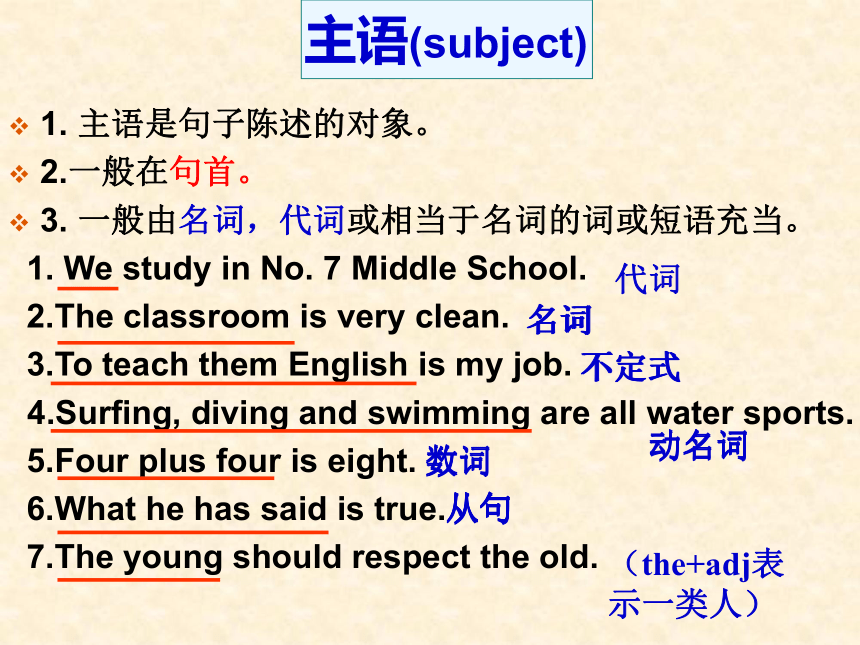
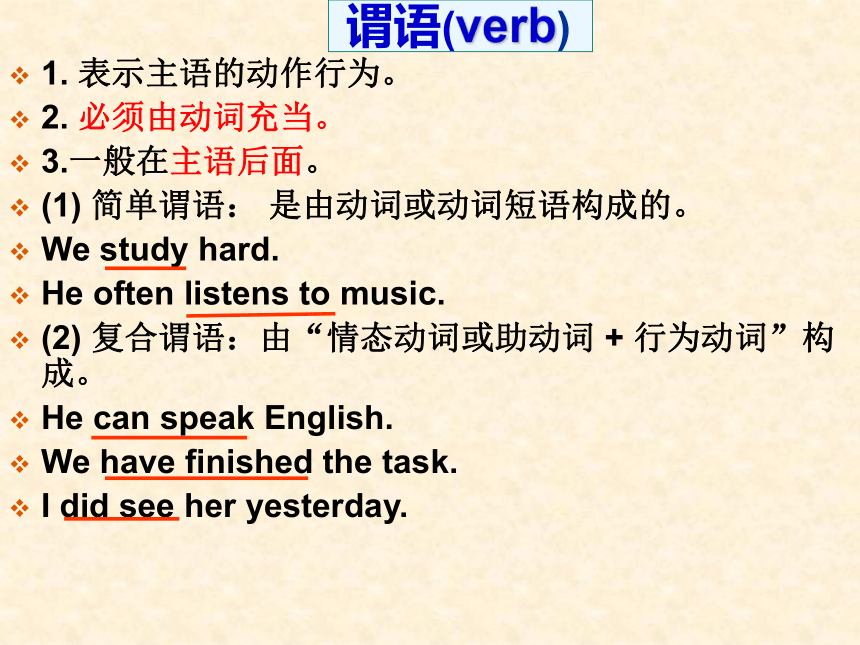
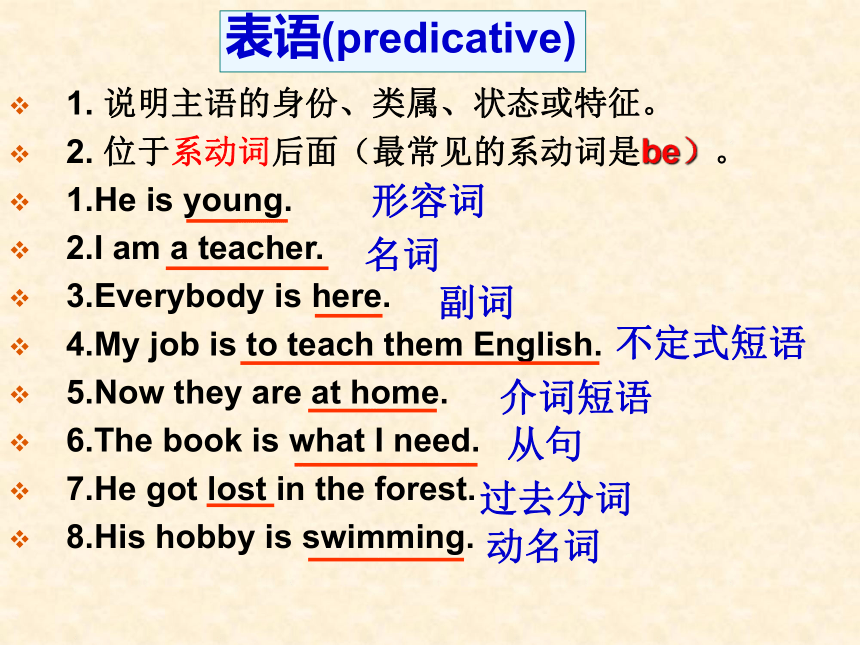
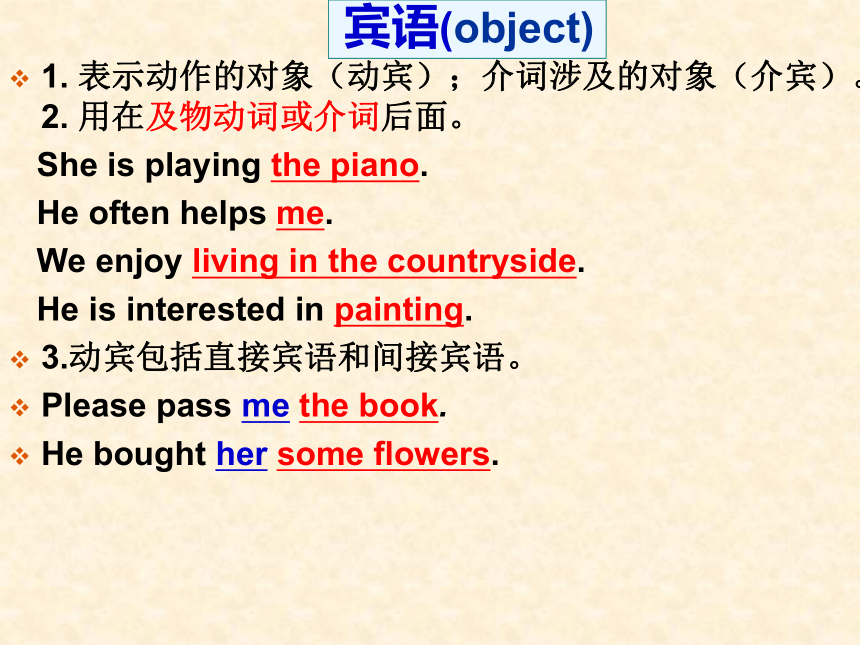
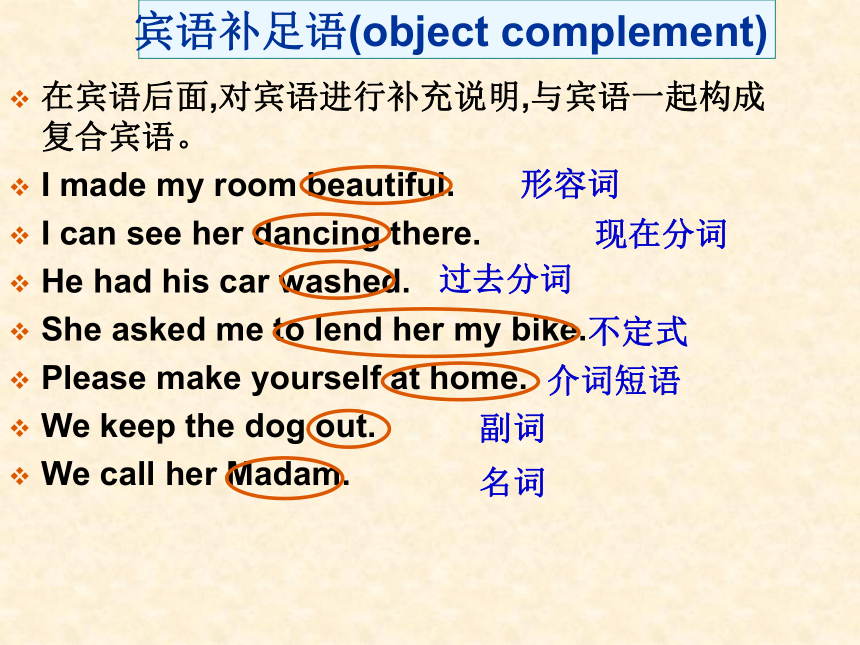

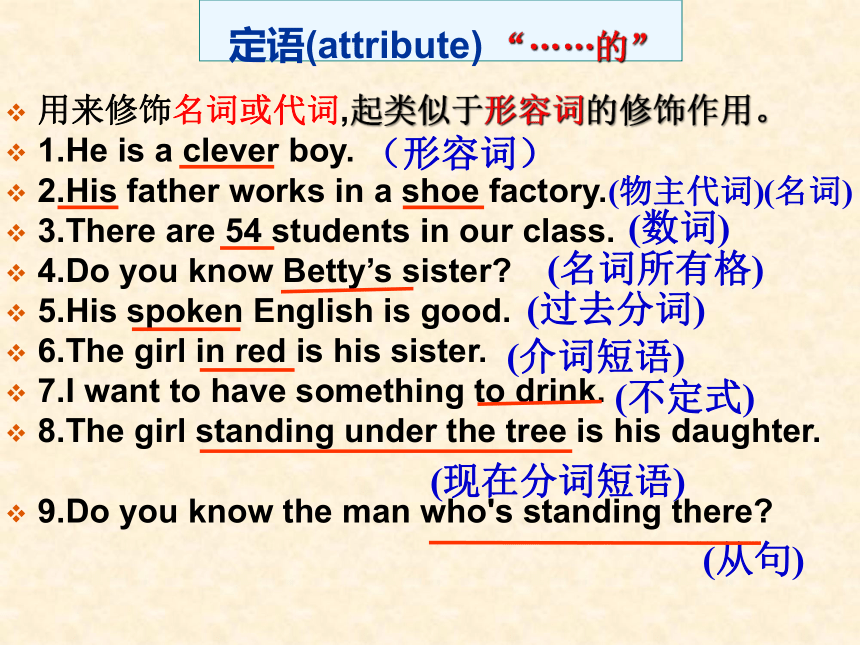
文档简介
(共30张PPT)
英语的句子成分
词类
名词n----------表示人或事物的名称
形容词adj-------表示人或事物的特征
副词adv------修饰动词、形容词、其他副词、句子
动词v----------表示动作或状态
代词pron----------代替名词、数词
数词num----------表示数量或顺序
冠词art----------限制名词的意义
介词prep-------表示名词、代词和其他词的关系
连词conj-------连接词与词或句与句
其他词性缩写
c/n = 可数名词,countable noun的缩写
u/n = 不可数名词,uncountable noun的缩写
pl = 复数,plural的缩写
vi = 不及物动词,intransitive verb的缩写
vt = 及物动词,transitive verb的缩写
you 你
happy 高兴的
three 三
quickly 迅速地
student 学生
cut 砍、割
a 一个
at 在...
and 和
oh 哦
pron.
adj.
num.
adv.
n.
v.
art.
prep.
conj.
interj. (感叹词)
Ex. Write down the part of speech of the following words:
二、句子成分的构成
句子的主干成分:
主语、谓语、宾语、表语
句子的次要成分:
定语、状语、补语(宾补、主补)、
插入语、同位语
主语(subject)
1. 主语是句子陈述的对象。
2.一般在句首。
3. 一般由名词,代词或相当于名词的词或短语充当。
1. We study in No. 7 Middle School.
2.The classroom is very clean.
3.To teach them English is my job.
4.Surfing, diving and swimming are all water sports.
5.Four plus four is eight.
6.What he has said is true.
7.The young should respect the old.
代词
名词
不定式
动名词
数词
从句
(the+adj表示一类人)
名词
不定式
动名词
数词
从句
从句
谓语(verb)
1. 表示主语的动作行为。
2. 必须由动词充当。
3.一般在主语后面。
(1) 简单谓语: 是由动词或动词短语构成的。
We study hard.
He often listens to music.
(2) 复合谓语:由“情态动词或助动词 + 行为动词”构成。
He can speak English.
We have finished the task.
I did see her yesterday.
表语(predicative)
1. 说明主语的身份、类属、状态或特征。
2. 位于系动词后面(最常见的系动词是be)。
1.He is young.
2.I am a teacher.
3.Everybody is here.
4.My job is to teach them English.
5.Now they are at home.
6.The book is what I need.
7.He got lost in the forest.
8.His hobby is swimming.
形容词
名词
副词
不定式短语
介词短语
从句
过去分词
动名词
宾语(object)
1. 表示动作的对象(动宾);介词涉及的对象(介宾)。2. 用在及物动词或介词后面。
She is playing the piano.
He often helps me.
We enjoy living in the countryside.
He is interested in painting.
3.动宾包括直接宾语和间接宾语。
Please pass me the book.
He bought her some flowers.
宾语补足语(object complement)
在宾语后面,对宾语进行补充说明,与宾语一起构成复合宾语。
I made my room beautiful.
I can see her dancing there.
He had his car washed.
She asked me to lend her my bike.
Please make yourself at home.
We keep the dog out.
We call her Madam.
形容词
现在分词
过去分词
不定式
介词短语
副词
名词
主语补足语(subject complement)
对主语进行补充说明。
Tom was seen dancing in his room.
I was elected monitor.
Our country will be made stronger.
定语(attribute) “……的”
用来修饰名词或代词,起类似于形容词的修饰作用。
1.He is a clever boy.
2.His father works in a shoe factory.
3.There are 54 students in our class.
4.Do you know Betty’s sister
5.His spoken English is good.
6.The girl in red is his sister.
7.I want to have something to drink.
8.The girl standing under the tree is his daughter.
9.Do you know the man who's standing there
(形容词)
(物主代词)
(数词)
(名词所有格)
(过去分词)
(介词短语)
(现在分词短语)
(从句)
(不定式)
(名词)
状语(adverbial)
1. 修饰动词,形容词,副词或整句。
2. 表示动作发生的时间,地点,目的,方式,程度,结果,条件,让步,伴随和情状等。
1.He did it carefully.
2.She is very crazy about it.
3.He comes to see us every day.
4.He lay on the grass,looking at the sky.
5.I'll come back in a while.
6.Without his help, we couldn't work it out.
7.He was late because of the heavy rain.
8.She was beautiful when she was a girl.
同位语(apposition)
1.对前面的名词或代词做进一步解释,说明它们的性质和情况。
2.在句中和前面的名词指同一人、同一物,同做一种句子成分。
1. Tom, our monitor, is a handsome boy.
2. I myself will do the experiment.
3. She is the oldest among them six.
4. The news that he is ill worries us.
名词
反身代词
数词
从句
插入语(parenthesis)
插入语指的是对一句话所做的附加解释。其作用是,补足句意,包括说话者的态度,或引起听话者的注意。以下句子带有常见的插入语:
1. That will be a good beginning, I hope.
2. He is a bad guy, you know.
3. Mr. Smith, I think, is at least 50 years old.
Ex.分析下列句子成分
1. Everyone laughed happily.
2. My brother,Jim, was elected monitor.
3. There is a river at the foot of the hill.
4. He bought his son some books.
Ex.分析下列句子成分
5. The young girl with long black hair is Kate.
6. I smell the cake.
7. The cake smells good.
8. I saw my friend Tom standing at the bus-stop.
三、句子类型
按结构分
1、简单句
2、并列句
3、复合句
简单句: 由一个主语(或并列主语)和一个谓语(或并列谓语)构成的句子。即一套主谓关系。
All roads lead to Rome.
1、一个主语和一个谓语动词
The teacher and the children are playing.
2、并列主语和一个谓语动词
He got up, dressed quickly, washed himself and went out.
3、一个主语和并列谓语
Tom and Mary came and gave me a present.
4、并列主语和并列谓语
Ex. 判断下列句子是简单句、并列句还是复合句:
1. We often study Chinese history on Friday afternoon.
2. The boy who offered me his seat is called Tom.
3. There is a chair in this room.
4. He is in Class One and I am in Class Two.
简单句
复合句
简单句
并列句
6. He was fond of drawing when he was yet a child.
7. What he said at the meeting is very important.
9. The farmer is showing the boy some flowers.
10. Both Tom and Jack enjoy country music.
复合句
复合句
简单句
简单句
简单句的五种基本句型
1、主语+谓:We work.
2、主语+系动词+表语:He is a student.
3、主语+谓语+宾语:She helped me.
4、主语+及物动词+双宾语(间接宾语+直接宾语)My teacher gave me a book.
5、主语+及物动词+复合宾语(宾语+宾补)
I saw her dancing.
判断下列句子的类型
(1) The problem is hard.
主+系+表
(2) The pen writes smoothly.
主+谓
(3) I showed him my old pictures.
主+谓+间宾+直宾
(4) He admits his mistakes.
主+谓+宾
(5) I saw a cat running across the road.
主+谓+宾+宾补
(6)Her face turned red.
主+系+表
Step1 Lead-in
句子主干
句子修饰成分1----状语
句子修饰成分2----定语
主+谓
主 + 谓 + 宾
主 + 谓 + 宾 + 宾补
主 + 谓 + 宾 + 双宾
主 + 系 +表
定语:“左二右六”
状语
1.悬挂结构
2.状语从句
3.介词短语
4.副词
“选壮姐夫”
主 + 谓 + 宾
英语句子中,有且只有两种修饰成分,即定语和状语。
分析句子的步骤
第一步:用 小三角形 标出谓语动词
第二步:圈出连词
第三步:括从句 (枝叶)
“一划二括三会意,读懂高考长难句”
1.找出谓语动词是关键。
Summary
2.注意连词的省略;
3.注意谓语动词的排比现象。
Goodbye!
英语的句子成分
词类
名词n----------表示人或事物的名称
形容词adj-------表示人或事物的特征
副词adv------修饰动词、形容词、其他副词、句子
动词v----------表示动作或状态
代词pron----------代替名词、数词
数词num----------表示数量或顺序
冠词art----------限制名词的意义
介词prep-------表示名词、代词和其他词的关系
连词conj-------连接词与词或句与句
其他词性缩写
c/n = 可数名词,countable noun的缩写
u/n = 不可数名词,uncountable noun的缩写
pl = 复数,plural的缩写
vi = 不及物动词,intransitive verb的缩写
vt = 及物动词,transitive verb的缩写
you 你
happy 高兴的
three 三
quickly 迅速地
student 学生
cut 砍、割
a 一个
at 在...
and 和
oh 哦
pron.
adj.
num.
adv.
n.
v.
art.
prep.
conj.
interj. (感叹词)
Ex. Write down the part of speech of the following words:
二、句子成分的构成
句子的主干成分:
主语、谓语、宾语、表语
句子的次要成分:
定语、状语、补语(宾补、主补)、
插入语、同位语
主语(subject)
1. 主语是句子陈述的对象。
2.一般在句首。
3. 一般由名词,代词或相当于名词的词或短语充当。
1. We study in No. 7 Middle School.
2.The classroom is very clean.
3.To teach them English is my job.
4.Surfing, diving and swimming are all water sports.
5.Four plus four is eight.
6.What he has said is true.
7.The young should respect the old.
代词
名词
不定式
动名词
数词
从句
(the+adj表示一类人)
名词
不定式
动名词
数词
从句
从句
谓语(verb)
1. 表示主语的动作行为。
2. 必须由动词充当。
3.一般在主语后面。
(1) 简单谓语: 是由动词或动词短语构成的。
We study hard.
He often listens to music.
(2) 复合谓语:由“情态动词或助动词 + 行为动词”构成。
He can speak English.
We have finished the task.
I did see her yesterday.
表语(predicative)
1. 说明主语的身份、类属、状态或特征。
2. 位于系动词后面(最常见的系动词是be)。
1.He is young.
2.I am a teacher.
3.Everybody is here.
4.My job is to teach them English.
5.Now they are at home.
6.The book is what I need.
7.He got lost in the forest.
8.His hobby is swimming.
形容词
名词
副词
不定式短语
介词短语
从句
过去分词
动名词
宾语(object)
1. 表示动作的对象(动宾);介词涉及的对象(介宾)。2. 用在及物动词或介词后面。
She is playing the piano.
He often helps me.
We enjoy living in the countryside.
He is interested in painting.
3.动宾包括直接宾语和间接宾语。
Please pass me the book.
He bought her some flowers.
宾语补足语(object complement)
在宾语后面,对宾语进行补充说明,与宾语一起构成复合宾语。
I made my room beautiful.
I can see her dancing there.
He had his car washed.
She asked me to lend her my bike.
Please make yourself at home.
We keep the dog out.
We call her Madam.
形容词
现在分词
过去分词
不定式
介词短语
副词
名词
主语补足语(subject complement)
对主语进行补充说明。
Tom was seen dancing in his room.
I was elected monitor.
Our country will be made stronger.
定语(attribute) “……的”
用来修饰名词或代词,起类似于形容词的修饰作用。
1.He is a clever boy.
2.His father works in a shoe factory.
3.There are 54 students in our class.
4.Do you know Betty’s sister
5.His spoken English is good.
6.The girl in red is his sister.
7.I want to have something to drink.
8.The girl standing under the tree is his daughter.
9.Do you know the man who's standing there
(形容词)
(物主代词)
(数词)
(名词所有格)
(过去分词)
(介词短语)
(现在分词短语)
(从句)
(不定式)
(名词)
状语(adverbial)
1. 修饰动词,形容词,副词或整句。
2. 表示动作发生的时间,地点,目的,方式,程度,结果,条件,让步,伴随和情状等。
1.He did it carefully.
2.She is very crazy about it.
3.He comes to see us every day.
4.He lay on the grass,looking at the sky.
5.I'll come back in a while.
6.Without his help, we couldn't work it out.
7.He was late because of the heavy rain.
8.She was beautiful when she was a girl.
同位语(apposition)
1.对前面的名词或代词做进一步解释,说明它们的性质和情况。
2.在句中和前面的名词指同一人、同一物,同做一种句子成分。
1. Tom, our monitor, is a handsome boy.
2. I myself will do the experiment.
3. She is the oldest among them six.
4. The news that he is ill worries us.
名词
反身代词
数词
从句
插入语(parenthesis)
插入语指的是对一句话所做的附加解释。其作用是,补足句意,包括说话者的态度,或引起听话者的注意。以下句子带有常见的插入语:
1. That will be a good beginning, I hope.
2. He is a bad guy, you know.
3. Mr. Smith, I think, is at least 50 years old.
Ex.分析下列句子成分
1. Everyone laughed happily.
2. My brother,Jim, was elected monitor.
3. There is a river at the foot of the hill.
4. He bought his son some books.
Ex.分析下列句子成分
5. The young girl with long black hair is Kate.
6. I smell the cake.
7. The cake smells good.
8. I saw my friend Tom standing at the bus-stop.
三、句子类型
按结构分
1、简单句
2、并列句
3、复合句
简单句: 由一个主语(或并列主语)和一个谓语(或并列谓语)构成的句子。即一套主谓关系。
All roads lead to Rome.
1、一个主语和一个谓语动词
The teacher and the children are playing.
2、并列主语和一个谓语动词
He got up, dressed quickly, washed himself and went out.
3、一个主语和并列谓语
Tom and Mary came and gave me a present.
4、并列主语和并列谓语
Ex. 判断下列句子是简单句、并列句还是复合句:
1. We often study Chinese history on Friday afternoon.
2. The boy who offered me his seat is called Tom.
3. There is a chair in this room.
4. He is in Class One and I am in Class Two.
简单句
复合句
简单句
并列句
6. He was fond of drawing when he was yet a child.
7. What he said at the meeting is very important.
9. The farmer is showing the boy some flowers.
10. Both Tom and Jack enjoy country music.
复合句
复合句
简单句
简单句
简单句的五种基本句型
1、主语+谓:We work.
2、主语+系动词+表语:He is a student.
3、主语+谓语+宾语:She helped me.
4、主语+及物动词+双宾语(间接宾语+直接宾语)My teacher gave me a book.
5、主语+及物动词+复合宾语(宾语+宾补)
I saw her dancing.
判断下列句子的类型
(1) The problem is hard.
主+系+表
(2) The pen writes smoothly.
主+谓
(3) I showed him my old pictures.
主+谓+间宾+直宾
(4) He admits his mistakes.
主+谓+宾
(5) I saw a cat running across the road.
主+谓+宾+宾补
(6)Her face turned red.
主+系+表
Step1 Lead-in
句子主干
句子修饰成分1----状语
句子修饰成分2----定语
主+谓
主 + 谓 + 宾
主 + 谓 + 宾 + 宾补
主 + 谓 + 宾 + 双宾
主 + 系 +表
定语:“左二右六”
状语
1.悬挂结构
2.状语从句
3.介词短语
4.副词
“选壮姐夫”
主 + 谓 + 宾
英语句子中,有且只有两种修饰成分,即定语和状语。
分析句子的步骤
第一步:用 小三角形 标出谓语动词
第二步:圈出连词
第三步:括从句 (枝叶)
“一划二括三会意,读懂高考长难句”
1.找出谓语动词是关键。
Summary
2.注意连词的省略;
3.注意谓语动词的排比现象。
Goodbye!
